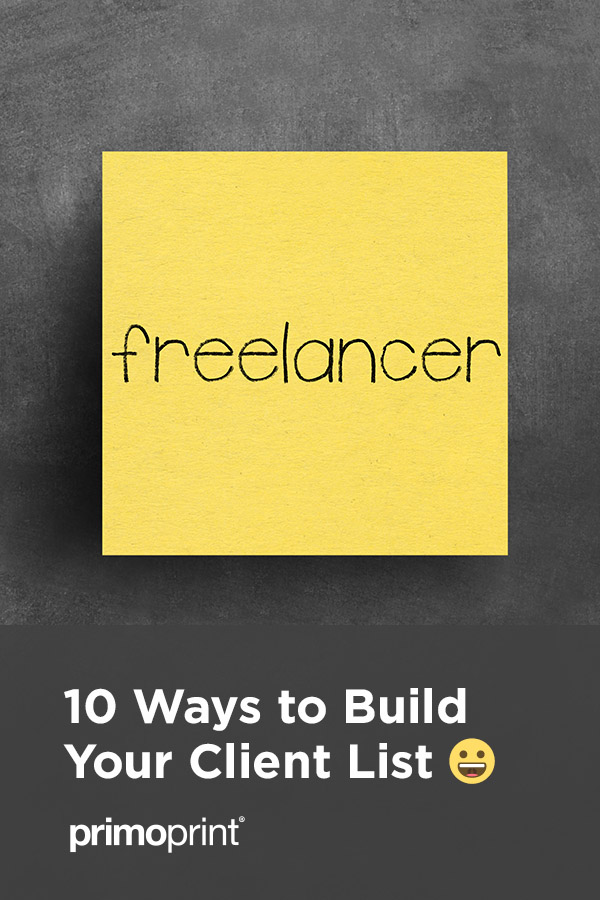Every freelancer has more than one job. No matter what their trade, they’re also a professional marketer, accountant, consultant and so much more. Whether you’ve just decided to start freelancing to escape the corporate life or you’ve been making money on your own for years, getting clients and expanding your network is an integral part of your career growth.
From developing a personal brand to making valuable connections that will propel your career forward, here are 10 tips to help you get more freelance clients.
1. Use More than Just LinkedIn to Find Clients
Although this social media platform is a staple for anyone in the workforce, it’s not the end-all, be-all. LinkedIn is a great way to apply for jobs, connect with people in your industry, and explore some interesting opportunities. But a LinkedIn profile isn’t the only way a freelancer should promote themselves or their work.
Do update your profile with noteworthy achievements and big projects, but don’t rely on LinkedIn solely to attract new clientele. In fact, your LinkedIn should be used as a platform to substantiate your image and network with other professionals, not attract new clients.
“But I still get messages from job recruiters all the time!” You may argue. Great! But are hiring recruiters your target audience? Unless you write B2B or work in career consulting, the majority of clients you want to work with aren’t going to magically stumble upon your LinkedIn profile and hire you based on that alone.
2. Sign Up for Industry-Specific Social Media
In this day and age, most professionals have separate social media accounts. Not only does this help them maintain a healthy work-life balance, but it allows them to showcase their work in a natural way and connect with other people in their job market.
Aside from the standard social media lineup (Twitter, Instagram, Facebook), there are also many industry-specific platforms that can help you get a foot in the door and start attracting new clients.
Here are some of the most popular you should check out:
- If you’re an illustrator, artist, or designer – Behance and Dribbble.
- If you’re a photographer – Flickr, Vero Social, and YouPic.
- If you’re a videographer – Vimeo.
These platforms will allow you to cultivate a stronger presence and always have samples of your work on hand.
Resource: The Ultimate Freelancing Guide
3. How to Reach Out to Your Dream Clients
You don’t have to be working directly with a client to benefit from them. In fact, rather than cold-calling, you should try to connect with companies you’d love to work for by asking them questions. This is a fantastic way to generate some inner knowledge about your preferred industry.
Let’s say that you’re a freelance graphic designer who really loves the culinary field. A restaurant you follow on social media recently updates its branding, and you’d love to know how that came to be.
Instead of just sitting around wishing you could get noticed by someone like them, send a message! Reach out on Facebook if they have a page (through a DM, not a public post) or send an email. Write something that offers leading questions and opens the doorway to greater insight.
Here’s an example:
Hello,
I am a big fan of your company, and I love the new graphics that you recently revealed! The new look is fantastic, especially (list some examples or key features).
I am a graphic designer and am hoping I could ask you some questions to learn more about how to better serve professionals like you. If you have the time, I’d love to hear your responses to these questions. This is just for my personal knowledge, so everything is strictly confidential.
- What made you decide to hire a graphic designer for your brand?
- How did you find a graphic designer for your brand, and why did you decide to hire them?
- What was the process of designing your new graphics like, and how did you communicate with the designer during the process?
Thank you for your time. I hope to hear from you soon!
Best,
Your Name
You should send several of these emails to companies/professionals that you admire, at least 5 but no more than 10 at once. Don’t go overboard, and don’t get discouraged if you don’t get a response. You may only get one the first time around.
The purpose of this isn’t to sign any new clients. It’s to gain valuable insight that will help you adjust your own marketing strategy and become more visible to the right clients for you.
You can also flip the script and reach out to some leading freelancers you happen to admire. Hit them up on Twitter or LinkedIn, and don’t be afraid to put yourself out there. You might find an incredible mentor, or even just make some new friends that can offer some much-needed advice.
Do you have any suggestions that have worked for you in reaching new clients? Leave a comment below!
4. How to Utilize Job Boards
A lot of freelancers are intimidated by job boards. They worry that they don’t have enough work experience to back them up, or that they’re going to apply for jobs and never get a single response.
One thing you have to accept as a freelancer is that you will get rejected. It can come in the form of a generic, copy-and-paste no-thank-you email, or it can just be radio silence after what seemed to be a decent conversation. Don’t sweat it; this isn’t a marker of failure, it’s just part of the job description.
Anyway, back to job boards. Use them. They’re incredibly helpful, and it’s a fantastic way to land your first freelance gig or connect with new clients that could bring you awesome new projects that beef up your portfolio. Here are a few to check out:
- We Work Remotely
- Authentic Jobs (Sounds fake but it’s legit, we promise)
- Smashing Jobs
- UpWork
- Krop
5. Revise Your Portfolio
A lot of freelancers make one common mistake with their portfolios: They design them to scream, “LOOK HOW AWESOME I AM! HIRE ME!” instead of “Here’s some great stuff I’ve done, and here’s how it can help you.”
People do not look at portfolios because they want to be wowed as if they’re drinking in an original Van Gogh at a museum. They want to see something that resonates with their problem and looks like a viable solution.
6. Check Out Shared Workspaces
One of the best parts about being a freelancer is getting to call pajamas your job uniform. But, as you’ve probably already figured out, building a network of other professional freelancers is tough when half of your workday is spent on your couch.
Try taking things outside and doing some work at a coworking space like WeWork or Alley. These spaces won’t just give you some fresh air and a chance at scenery; you’ll also get to meet other remote workers and possibly make some valuable connections. Learn more about the advantages and disadvantages of coworking spaces.
7. Create Content
You do not have to be a freelance writer to run a killer blog that attracts new clients. In fact, the best way to stand out in any professional industry in today’s highly oversaturated market is to showcase your personality through content.
A blog can easily be integrated into your portfolio site using a hosting platform like Squarespace, and you’ll be able to market yourself just by talking about what you love. You want to write content that demonstrates your know-how and offers your target audience solutions to their problems.

Write about what you do, make listicles (e.g. 10 Things to Ask Before Hiring a Freelance Graphic Designer), or write FAQs. There are plenty of options for content. Don’t hold yourself back because it’s been done before. Put your own spin on it.
When it comes to affordable marketing strategies for freelancers, this is among the best. It’s entirely free to create, and you can spend anywhere from $30-100 on social media platforms to attract views.
8. Ask Your Friends for Connections
You’d be surprised at how some people find their best clients. Let your friends know that you’ve started a freelance business or you’re looking to gain more exposure. Send them links to your portfolio and have them pass it around. You may just score your next gig this way.
9. Keep Expanding Your Skill Set
We’re not saying you should become a one-man-band freelancer, but it doesn’t hurt to diversify your offerings. You can customize your skills and make them applicable to your industry and clients, so a photographer who also happens to know web design can create a package that helps clients showcase the work they had shot for them.
Continually improving your skills and learning new ones also help you prevent stagnation.
10. Make a Useful Product
People love free stuff, and offering something valuable to your clients without charge can showcase your talents and potentially attract new business. If you’re a writer, offer a free PDF on how to hire a freelance writer or some content writing tips. If you’re a developer, put together a quick app that helps people in your industry.
Freelancers do have to work for, well, free if they want to expand their portfolio and make a name for themselves. It’s not for the faint of heart, but the freedom, creative liberty, and sense of fulfillment that comes from running your own freelance business makes it all worthwhile. Also, keep in mind that the work you do now is still useful if you decide to return to a company later.
Any portfolio you create while you freelance will show potential employers that you’re a fantastic self-starter, highly motivated, and resourceful: Three things no one can ever complain about.



